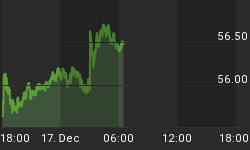
Much has been made of the 203 thousand jobs that were added in the November employment report in the US. It was the second month in a row for 200 thousand plus jobs created. As well, the unemployment rate unexpectedly fell to 7% from 7.3%. This occurred despite the participation rate actually rising from 62.8% to 63%. This immediately brought out "taper" talk for the December FOMC that is on next week December 17-18.
Despite all of the excitement there has generally been little to get excited about. The underlying statistics continue to suggest that the job market is not really improving to the extent that desired. No doubt the members of the FOMC realize that despite their misgivings about the ongoing wisdom of continuing with the current QE program of $85 billion a month.
The reality is that the current QE program is not doing that much good because the banks are not to any great extent lending the money out. Instead as pointed out here and elsewhere the funds are being kept by the banks in the form of excess reserves held with the Fed where they can earn a higher rate of interest then purchasing US T Bills. As well, it is safer just holding it with the Fed then purchasing other securities or lending it out to questionable borrowers.
Even if the Fed were to "taper" say $10 billion a month which is what is currently expected it would not have much impact on the growth of the Fed's balance sheet or the US monetary base.
But it is the job numbers that have to be of concern. The unemployment rate reported each month is what is known as U3 unemployment or core unemployment. The current U3 rate is actually just below the peak seen during the early 1990's recession and well above the peak of the 2002 recession. In looking at the unemployment rate over the past 50 years or so the current rate has only been exceeded by the 1974-1975 recession and the early 1980's recession. At the peak of the 2008-2009 recession the unemployment rate was only exceeded by the early 1980's recession and the Great Depression.
What the chart above shows is that full-time jobs remain below their peak seen prior to the 2008-2009 recession while part-time jobs have grown considerably. Full-time jobs have grown by 6,359 thousand since the trough in December 2009 but are down 4,535 thousand since early 2008. On the other hand part-time jobs have grown 2,760 thousand since early 2008. On a net basis the bulk of the jobs created since 2008 has been part-time jobs.
Part-time jobs are low paying jobs. According to the Bureau of Labour Statistics (BLS) some 59% of all wage and salary workers or 75.3 million workers are paid hourly. Of that, some 3.6 million were paid the minimum federal wage or lower. More than half of US wage earners earn less than $30,000 per year including some 15% of the US working population that earns $5,000 a year or less. Grant you some of these workers might be students working part time.
What the unemployment rate doesn't reflect is discouraged workers. The current underemployment rate of the U6 unemployment rate which includes short term discouraged workers plus part-time workers that want full-time jobs sits at 13.2%. This is down from the peak of 17.1% seen in April 2010. The current U6 rate remains higher than what it was from 1994-2008 when they started tracking the U6 unemployment rate.
Shadow Stats www.shadowstats.com tracks the discouraged workers defined away by 1994 revisions to the labour force. These workers are no longer considered a part of the labour force. Unlike the U3 and U6 rate this number has not been falling. Instead it has been rising currently sitting at 23.2% down from its peak in October 2013 at 23.5%. Since the recession got underway in 2008, this number has grown from 12.9% to its current level.
Some of this shows up in the civilians unemployed 27 weeks or longer. As the chart shows while the number has fallen it remains sharply above any levels seen over the past 50 plus years. The longer they remain out of work the harder it is for them to get back into the market.

Yet the number not in the labour force just keeps on growing. Surely not all of these people are just sitting at home on disability payments?


But that is just the median duration of unemployment. The average (mean) duration of unemployment is even higher. Not only is it sharply above any previous period over the past 50 plus years it has barely come down.

The picture of employment in the US is not particularly pretty. The majority of jobs are being created in low-wage paying sectors, people are staying unemployed for a longer period of time and the army of discouraged workers is growing not falling.
The official unemployment numbers are not giving a true picture. Despite that the official U3 unemployment rate is moving in the direction the Fed wants it to go in. But it is still not down to 6.5% level that the Fed has considered to be level necessary to start pulling back on QE. And behind those numbers lies bleaker numbers. "Taper"? Not likely at this time. That the stock market, interest rates and gold are petrified of the Fed "tapering" speaks volumes for how weak the economy might really be. "Taper" talk appears to be just that - talk.















